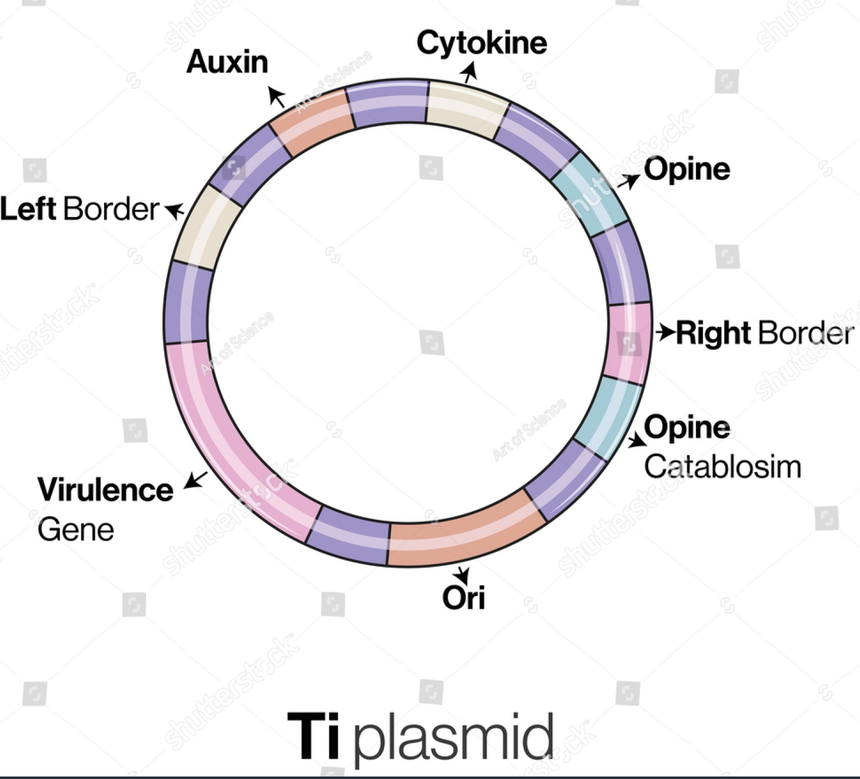Ti Plasmid Full Form
What is the full form of TI Plasmid ?
The expanded form of the Ti plasmid is a tumor-inducing plasmid present in Agrobacterium tumefaciens. It is an extrachromosomal molecule of DNA responsible for causing crown gall disease in some dicot plants. It causes infection in damaged or wounded plants. There are mainly two types of plasmids based on the source of energy they use. The approximate size of the Ti plasmid is 250 kB and its molecular weight is 120 -160 mega Dalton. Ti plasmid contains 196 genes that code for 195 proteins. To know more about Ti plasmid, continue reading this article.
Types of Ti Plasmid
There are two important types of Ti plasmids.
Nopaline: the length of this type of Ti plasmid is approximately 25 kilobytes. This type of Ti plasmid mostly has a continuous region of T-DNA. The opine produced by this Ti plasmid is nopaline.
Octopine: Octopine was first isolated in 1927 from Octopus octopodia. It is divided into two regions of 13kB and 8kB.
History of Ti Plasmid
Agrobacterium tumefacient is a gram-negative bacteria.
It belongs to a class of alphaproteobacteria.
These plasmids have a conserved DNA region known as the repABC gene cassette.
It is a pathogenic species of the family; caulobacter, rhizobium, and rhodobacter are some non-pathogenic and symbiotic species of this class.
These genes are also known to cause tumors in plants by transferring some of the genes.
The Vir gene region and the t DNA region were characterized between 1980 and 2000. The T-DNA study helped scientists understand the mechanism of the transfer of genes from a bacterial cell to a plant cell.
Features of the Ti Plasmid
The following are some of the important features of the Ti Plasmid:
Ori site: it is also known as the origin of replication. It is the region in plasmid DNA from which replication starts.
T-DNA: it is the important region in ti plasmids this region is transferred in the plant cell for Infection.
Opine catabolism is the region in Ti plasmid from where bacteria get their nutrition. Opines can be catabolized and used as nutrients; generally, opianes are derivatives of a sugar phosphate and an amino acid.
Virulence region: the virulence gene of the Ti plasmid forms the virulence protein,which is responsible for transferring T-DNA to plant cells.
Plant hormone synthesizes region: this gene codes for proteins or enzymes that further make important plant hormones such as auxin and cytokinin.
Ti-plasmid conjugation region: this process helps in transferring the Ti-plasmid from one cell to another.

Applications of Ti Plasmid
Ti plasmids are widely used in biotechnology. Ti Plasmids can modify the genetic material of plant cells. This property of Ti Plasmids to modify the genetic material of plant cells is used in biotechnology.
So, tumor-inducing genes in the plasmid are replaced by genes of interest, and as a result, plants with better quality and quantity are produced.
In this manner, desirable genes are introduced into plants, and new characters appear.
Limitation of the Ti Plasmid
Ti plasmids are widely used in biotechnology, but they also have some limitations. These limitations are explained below:
A Ti plasmid cannot be used in monocot plants to transfer genetic material.
Ti plasmid is quite very large. So it cannot be used in many cases where small-length plasmids are required.
It can work only in plants that get infected by Agrobacterium tumefaciens.
Frequently Asked Questions (FAQs)
It is a disease in which adventitious roots grow very rapidly and intensely in plants. These roots grow as a result of Agrobacterium rhizogenes infection.. After infecting the plant roots, the plasmid transfers its DNA to the plant.
Soft root disease is a disease of rubber plants. This disease is caused by many bacterial species. Some of the species are pseudomonas, bacillus, and clostridium.
The main steps in cloning are:
Isolation of a gene of interest
Ligation of the gene of interest in the plasmid
Transformation of the host cell
Selection or screening procedure.
The expanded form of Ri plasmid is a root-inducing plasmid found in Agrobacterium rhizogenes. These cause hairy root diseases in monocots.
E. coli is used as a host in many recombinant DNA technologies or processes for the production of proteins and enzymes. The main reasons for using E.coli in these procedures are its well-known genetics, its simplicity, and the large number of molecular tools available for E.coli.